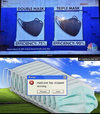I found a video of the guy who created PCR and he stated that it's NOT diagnostic. It's just a tool to create a shit ton more of something from a tiny amount of something. The debate around it actually came out during the HIV/AIDS epidemic.I'm not a conspiracy guy, there is actual data in the article. I believe Anderson750 called out the CT count a while ago, but could not find it.
I was convinced there was no way the ruling class would be so bold as to solve corona shortly after the election, but Cuomo already stated the lock downs have to be lifted. I'll be interested to see if that trend continues.
You are using an out of date browser. It may not display this or other websites correctly.
You should upgrade or use an alternative browser.
You should upgrade or use an alternative browser.
Coronavirus
- Thread starter Kevin B.
- Start date
anderson750
I'm working on it Rose
- Location
- Price, Utah
I believe my statements were that I believed that the test may have a high sensitivity, but a low specificity. In other words, this coronavirus shares similarities to other coronaviruses. When you are amplifying the product you are to have it show up in a level that the test can safely detect, then you are also amplifying things that can interfere and cause a false positive. The more you amplify, the more you need to be able to weed out and exclude things that are close but not the actual part you are looking for.I'm not a conspiracy guy, there is actual data in the article. I believe Anderson750 called out the CT count a while ago, but could not find it.
I was convinced there was no way the ruling class would be so bold as to solve corona shortly after the election, but Cuomo already stated the lock downs have to be lifted. I'll be interested to see if that trend continues.
PCR testing also requires some very close attention to procedures that prevent any kind of cross contamination and cleaning. If you have a positive sample and clean room procedures break down, you can have cross contamination in future tests. I worked for 3 years in the lab at the University of Utah where all the organ and bone marrow transplant testing is done. Some tests are done on a DNA level and there are a lot of steps along the way that can effect results. Now with this PCR coronavirus, I am sure that it is an automated process unlike the manual processes we did, but just because it is automated, it does not eliminate human errors.
Tests like these usually take years to develop and refine and this one came to market in the mater of a few months.
glockman
I hate Jeep trucks
- Location
- Pleasant Grove
I've spent a lot of my 20 years in semiconductors in clean rooms and all of it working with automation. I can relate to both being less than perfect.I believe my statements were that I believed that the test may have a high sensitivity, but a low specificity. In other words, this coronavirus shares similarities to other coronaviruses. When you are amplifying the product you are to have it show up in a level that the test can safely detect, then you are also amplifying things that can interfere and cause a false positive. The more you amplify, the more you need to be able to weed out and exclude things that are close but not the actual part you are looking for.
PCR testing also requires some very close attention to procedures that prevent any kind of cross contamination and cleaning. If you have a positive sample and clean room procedures break down, you can have cross contamination in future tests. I worked for 3 years in the lab at the University of Utah where all the organ and bone marrow transplant testing is done. Some tests are done on a DNA level and there are a lot of steps along the way that can effect results. Now with this PCR coronavirus, I am sure that it is an automated process unlike the manual processes we did, but just because it is automated, it does not eliminate human errors.
Tests like these usually take years to develop and refine and this one came to market in the mater of a few months.
xjtony
Well-Known Member
- Location
- Grantsville, Ut
While I do know people personally that have families that have been hit fairly hard by this whole thing if we look at the death rate, which is probably the least inflated rona number that we can get our hands on, in the US we are looking at a total of .123% of the population (405000 people). Again I wont downplay that 400K people have died, but if the media reported the percentage instead of the number I think people would have a totally different view of the issue.
xjtony
Well-Known Member
- Location
- Grantsville, Ut
Yup i'm an idiot@TRD270 Its a percent you gotta bump the decimal. 405000 of 328000000 (2019 estimated population) is .123475609%
xjtony
Well-Known Member
- Location
- Grantsville, Ut
I actually had to go back and fix it before I hit post reply lolYup i'm an idiot
anderson750
I'm working on it Rose
- Location
- Price, Utah
And if you break it down even further and look at co-morbidities vs coronavirus only, the numbers are miniscule. Not down playing it at all, but if you use science and math to evaluate it, it will leave you scratching your head.While I do know people personally that have families that have been hit fairly hard by this whole thing if we look at the death rate, which is probably the least inflated rona number that we can get our hands on, in the US we are looking at a total of .123% of the population (405000 people). Again I wont downplay that 400K people have died, but if the media reported the percentage instead of the number I think people would have a totally different view of the issue.
Hey they won no need for the ministry of truth to push the agenda anymore until they choose what they want the sheep to believe next.
anderson750
I'm working on it Rose
- Location
- Price, Utah
I thought the inauguration would stop some of the nonesense coming from this clown but apparently not.

 nypost.com
nypost.com

Fauci: Wearing two masks is better than one
Two face masks are better than one, Dr. Anthony Fauci said Monday. The infectious diseases specialist advised that double-masking is a logical way to curb the spread of the coronavirus. “If y…
Spork
Tin Foil Hat Equipped
- Location
- Saratoga Springs, UT
anderson750
I'm working on it Rose
- Location
- Price, Utah
Next recommendation to come is going to be a plastic bag over your head with duct tape around your neck.
- Location
- Never Far From Nowhere
I know a few people I'd love to have follow that recommendation.Next recommendation to come is going to be a plastic bag over your head with duct tape around your neck.
- Location
- Grantsville, Utah
Next recommendation to come is going to be a plastic bag over your head with duct tape around your neck.
That might help humanity.
This country is full of people who believe things they are told despite libraries of evidence to the contrary. This isn't new or different. We're a society of believers.
We can all at least agree that numbers, however skewed they may or may not be, are at least trending in the right direction and with any luck we can put this nonsense behind us by mid year.
We can all at least agree that numbers, however skewed they may or may not be, are at least trending in the right direction and with any luck we can put this nonsense behind us by mid year.
I thought the inauguration would stop some of the nonesense coming from this clown but apparently not.

Fauci: Wearing two masks is better than one
Two face masks are better than one, Dr. Anthony Fauci said Monday. The infectious diseases specialist advised that double-masking is a logical way to curb the spread of the coronavirus. “If y…nypost.com

Spork
Tin Foil Hat Equipped
- Location
- Saratoga Springs, UT
Not four? Going to have to label you a SCIENCE denier!Personally, I'm for three masks. It's the trinity of safety.



